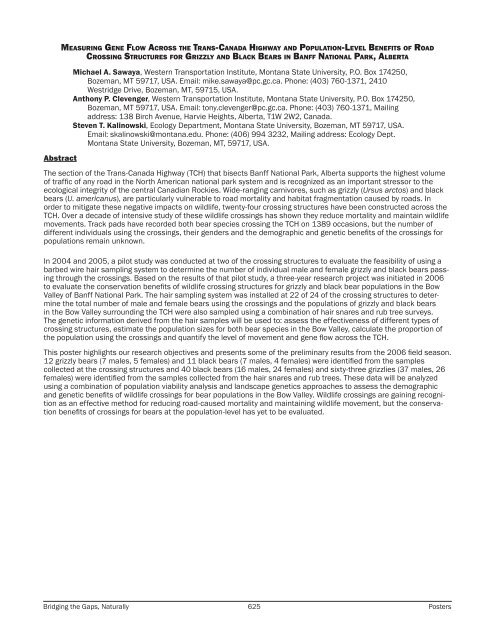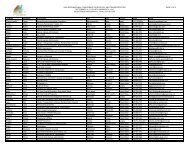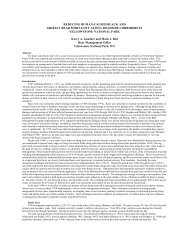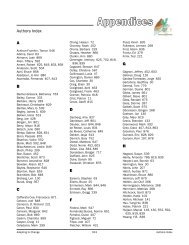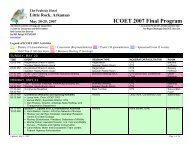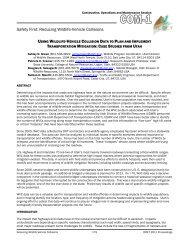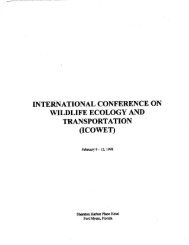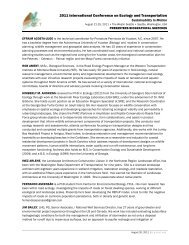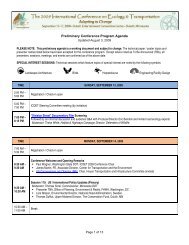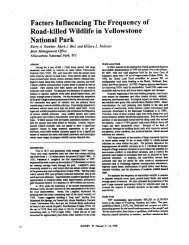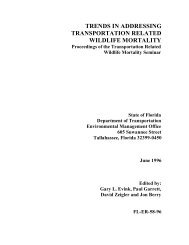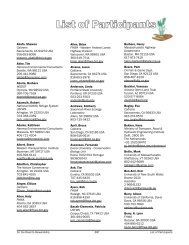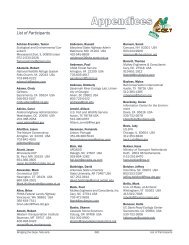Poster Sessions, pages 567-640 - ICOET
Poster Sessions, pages 567-640 - ICOET
Poster Sessions, pages 567-640 - ICOET
Create successful ePaper yourself
Turn your PDF publications into a flip-book with our unique Google optimized e-Paper software.
Abstract<br />
Measuring Gene Flow Across the Trans-Canada Highway and Population-Level Benefits of Road<br />
Crossing Structures for Grizzly and Black Bears in Banff National Park, Alberta<br />
Michael A. Sawaya, Western Transportation Institute, Montana State University, P.O. Box 174250,<br />
Bozeman, MT 59717, USA. Email: mike.sawaya@pc.gc.ca. Phone: (403) 760-1371, 2410<br />
Westridge Drive, Bozeman, MT, 59715, USA.<br />
Anthony P. Clevenger, Western Transportation Institute, Montana State University, P.O. Box 174250,<br />
Bozeman, MT 59717, USA. Email: tony.clevenger@pc.gc.ca. Phone: (403) 760-1371, Mailing<br />
address: 138 Birch Avenue, Harvie Heights, Alberta, T1W 2W2, Canada.<br />
Steven T. Kalinowski, Ecology Department, Montana State University, Bozeman, MT 59717, USA.<br />
Email: skalinowski@montana.edu. Phone: (406) 994 3232, Mailing address: Ecology Dept.<br />
Montana State University, Bozeman, MT, 59717, USA.<br />
The section of the Trans-Canada Highway (TCH) that bisects Banff National Park, Alberta supports the highest volume<br />
of traffic of any road in the North American national park system and is recognized as an important stressor to the<br />
ecological integrity of the central Canadian Rockies. Wide-ranging carnivores, such as grizzly (Ursus arctos) and black<br />
bears (U. americanus), are particularly vulnerable to road mortality and habitat fragmentation caused by roads. In<br />
order to mitigate these negative impacts on wildlife, twenty-four crossing structures have been constructed across the<br />
TCH. Over a decade of intensive study of these wildlife crossings has shown they reduce mortality and maintain wildlife<br />
movements. Track pads have recorded both bear species crossing the TCH on 1389 occasions, but the number of<br />
different individuals using the crossings, their genders and the demographic and genetic benefits of the crossings for<br />
populations remain unknown.<br />
In 2004 and 2005, a pilot study was conducted at two of the crossing structures to evaluate the feasibility of using a<br />
barbed wire hair sampling system to determine the number of individual male and female grizzly and black bears passing<br />
through the crossings. Based on the results of that pilot study, a three-year research project was initiated in 2006<br />
to evaluate the conservation benefits of wildlife crossing structures for grizzly and black bear populations in the Bow<br />
Valley of Banff National Park. The hair sampling system was installed at 22 of 24 of the crossing structures to determine<br />
the total number of male and female bears using the crossings and the populations of grizzly and black bears<br />
in the Bow Valley surrounding the TCH were also sampled using a combination of hair snares and rub tree surveys.<br />
The genetic information derived from the hair samples will be used to: assess the effectiveness of different types of<br />
crossing structures, estimate the population sizes for both bear species in the Bow Valley, calculate the proportion of<br />
the population using the crossings and quantify the level of movement and gene flow across the TCH.<br />
This poster highlights our research objectives and presents some of the preliminary results from the 2006 field season.<br />
12 grizzly bears (7 males, 5 females) and 11 black bears (7 males, 4 females) were identified from the samples<br />
collected at the crossing structures and 40 black bears (16 males, 24 females) and sixty-three grizzlies (37 males, 26<br />
females) were identified from the samples collected from the hair snares and rub trees. These data will be analyzed<br />
using a combination of population viability analysis and landscape genetics approaches to assess the demographic<br />
and genetic benefits of wildlife crossings for bear populations in the Bow Valley. Wildlife crossings are gaining recognition<br />
as an effective method for reducing road-caused mortality and maintaining wildlife movement, but the conservation<br />
benefits of crossings for bears at the population-level has yet to be evaluated.<br />
Bridging the Gaps, Naturally 625 <strong>Poster</strong>s


